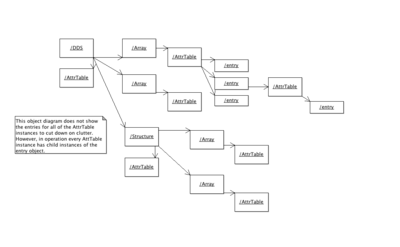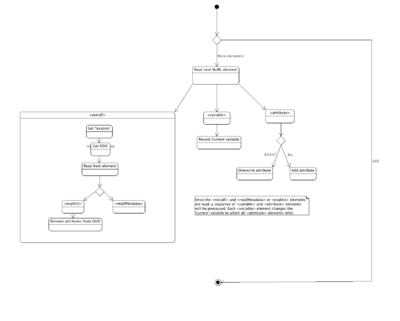Augment the Response
Back: AIS Using NcML
Organization of Instances in Memory
Object diagram:
A high resolution version of the figure to the right.
The object diagram to the right shows the organization in memory of class instances that corresponds to a fictitious data set. The DDS instance is the root of the data set and contains its name. Each variable in the data set is represented by an instance of a class that is a child of BaseType. In the picture, I used Array and Structure objects and I left out the child objects of the Array class that determine the type of the array to emphasize the relationship between the variables and the attribute tables. Each of these 'type classes' is a child of the BaseType class and that class includes an AttrTable (DAP attribute table) instance. Each AttrTable instance uses zero or more instances of the entry class to hold actual DAP attribute values.
Note: The online reference documentation for libdap, which provides all of these classes.
Processing the NcML Elements
State diagram:
A high resolution version of the NcML parsing state diagram.
The diagram to the right shows how the NcML elements are to be processed. Initially the <netcdf> element is processed and the target data source is read as the vale of the netcdf@location attribute. At the same time the readMetadta or explicit elements are read and the DDX fetched. If the explicit element is found, the the DAP attributes are all removed from the DDX's DDS and BaseType instances.
After processing the initial part of the NcML document, a sequence of variable and attribute elements are read. Each variable element updated the current variable. The NcML handler can maintain a pointer to the BaseType instance that corresponds to this variable. When attribute elements are processed they are applied to the 'current' BaseType instance.
The easiest way to traverse (and modify in the case of the AttrTAble and/or entry instances) is to use the class's iterator objects. For the AttrTable class, there are two different interfaces present, one which is older and uses names to find values and a newer one that uses C++ iterators. Use the iterator-based interface whenever possible.

